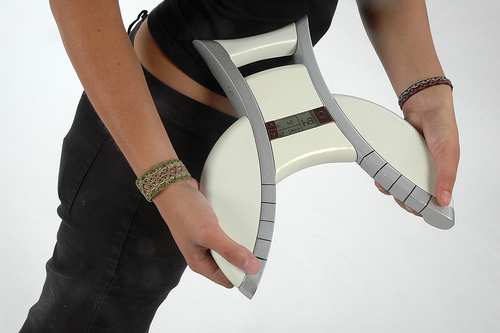The quest to reinvent the piano-style keyboard continues. Inventors have updated two efforts to design button-covered instruments with alternative pitch layouts. Is this a musical revolution — or just an attempt to play faster scales with less practice that will result in repetitive stress injuries?

First up, the Thumtronics Jammer, which has made a couple of appearances on Music thing. Most recently, Futuremusic reports the Jammer has now shown itself in public in Perth, Australia. The current prototype has buttons on top and joysticks for expression, though it looks like someone liberated the two joysticks a bit from a Sony PS2 Dual Shock controller. And all of this is supposed to “revolutionize music education” by making theory easier to understand on the isometric button layout. $1.5 million has been spent on its development (meaning those probably aren’t PS2 joysticks after all); a shipping product could appear in fall 2006 after “another infusion of investment capital.”
If you want to be the one to help infuse this project with cash, in fact, a recorded voice-over on the Thummer site suggests you buy shares. You can’t buy the product, but you can invest in the company. I think I’ll pass on this one, personally.

In other alternative keyboard news, and to me far more interesting, we have Eitan Shafer’s new musical instrument design, via Music thing (which has some additional commentary). Eitan didn’t have $1.5 million — he just had a design school assignment to complete. The results look a bit like a futuristic exercise gadget, and there are overtones of the “music theory for dummies” approach of the Thummer: an LED shows you what scale you’re playing. But the design is unusually finished looking, especially for this kind of project, and has one very cool feature: tilting it gives you control over pitch and effects. Oddly enough, the inspiration for all of this was the New York-based Samchillian, a circuit-bent QWERTY keyboard controller. It’s proof that the blog-connected Web we all live in can help spread new ideas.
I’m still working on the phrase “a musical instrument based on relativity.” I think an instrument truly inspired by special relativity would be fascinating: the faster you played, the shorter the keyboard would get, and it would seem to your band mates like you were playing at a different tempo, relative to their speed. Um . . . wait . . . actually, I think I’ve already experienced that.
The more you see new instrument ideas, the more you appreciate the simplicity and elegance of the piano keyboard, and other traditional instrument designs. But that’s a good thing — and that’s part of why experiments are valuable. Now, if you’ll excuse me, I’m going to go practice . . . because my keyboard controllers are unlikely to become isometric any time soon.
thought you'd have something up about that "relative keyboard thing". seems pretty cool to me. and fun. (other one is interesting, too, but i heard about it before and it looks expensive . . )
anyway, one thing that seems like a turn off at first to me is that it seems to rely on a set scale. could you tell if the thing would be effective with a chromatic scale? or is there an easy way to use notes outside of your set scale? if not, seems like that would be limiting.
but overall there are a lot of cool things about it. it's truly a different way of controlling music compared to a keyboard, rather than just looking different. it looks like it's fun to play. and i think it'd be fun to watch someone perform with it, too.
You can play any scale with either of these devices. I was more concerned about doing this small movement all the time — sounds like a recipe for potential injury. I'd be careful with it.
As for being fun to watch, absolutely! Though that definitely depends on the player. I'm sure someone could make either of these really cool to watch onstage — but that has more to do with the player than the invention.